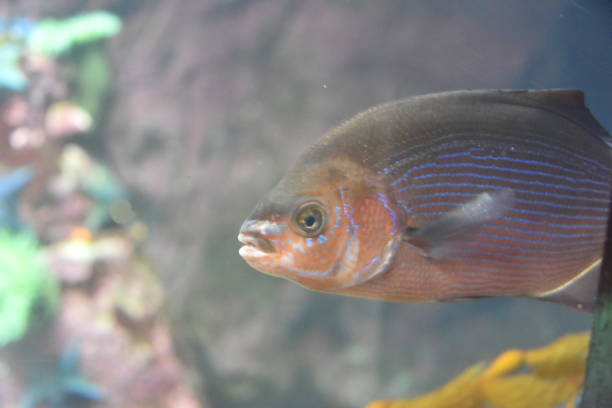ANIMAL: Striped Surfperch Embiotoca lateralis Type of Animal: Surfperch Habitat: Rocky areas w/ dense algae growth, rocky coasts, kelp beds, sandy surf near rocks, shallow rocky shore waters near bottom, cold water rocky bottoms, shallow kelp areas, rocky reefs, bays, estuaries, can be found in waters from surface all the way to depths of 312 ft Location(s): NE Pacific from SE Alaska to Baja California Appearance: Deep oval shaped compressed fish w/ copper background color & blue & orange horizontal stripes, head has series of blue spots & stripes, coppery fins Food/Diet: Shrimp, crabs, marine worms, brittle stars, fish eggs, bryozoans, bivalves, gastropods, sea urchins, isopods, gammarid amphipods Status in Wild: Stable Conservation: Limits on how many fish are caught & certain fishing seasons Lifestyle: Small schools of 10-70 fish Additional Info: Called: Male Female Young: Fry Group: School Weight: Male: 0.8-1.3 lbs Female: 1-2 lbs Gestation: 6.5-7 months Life Span: 6-10 years Body Length: Male: 8.6-12.5 in Female: 9.8-16 in Young: 4 in Tail Width: 3.5 in, same for both sexes Main predators are striped bass, California halibut, Pacific bonito, lingcod, salmon, rockfishes, kelp bass, barred sand bass, sharks, seals, river otters, great blue herons, terns, cormorants, loons, osprey, gulls, & electric rays. These fish viviparous w/ females giving birth to 11-92 live young. Reach maturity at 2 years old. Fry typically born between April & June. Also called Striped Seaperch, Blue Perch, Mojarra Azul, Rainbow Perch, Perca, Squawfish, Crugnoli, & Striped Perch. Active during the day (diurnal). Often compete w/ closely related Black Surfperch for food. Interestingly, juveniles of both species often co-mingle. Females move to shallower waters to give birth. Typically breed between August & October. Deeper water occurrences more frequent in summer & fall. Males perform courtship dances to attract females. Fun Fact(s): Sometimes used as baitfish for larger fish. Fairly popular food fish (especially for pan-frying). Even more popular as sport fish. These fish have soft texture & rather mild flavor. Many anglers avoid fishing for them in the spring since that is when females give birth.
